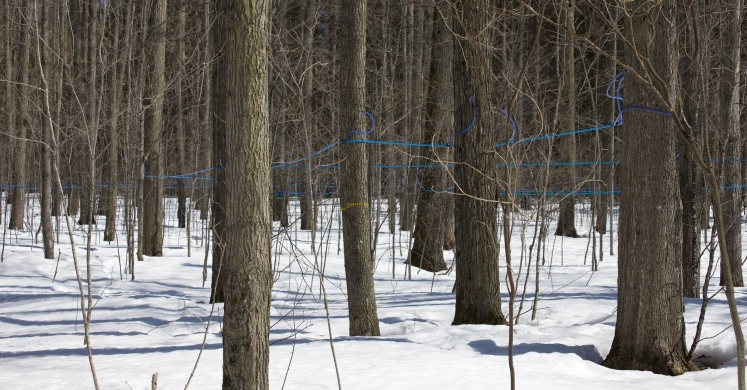Blog

#bioPGH Blog: Maple Syrup Season
 A resource of Biophilia: Pittsburgh, #bioPGH is a weekly blog and social media series that aims to encourage both children and adults to reconnect with nature and enjoy what each of our distinctive seasons has to offer.
A resource of Biophilia: Pittsburgh, #bioPGH is a weekly blog and social media series that aims to encourage both children and adults to reconnect with nature and enjoy what each of our distinctive seasons has to offer.
Have you ever read Laura Ingalls Wilder’s Little House in the Big Woods? One of the treasured memories described is the story of the maple sap collecting and the sugaring-off dance at Grandma and Grandpa’s house. Through the early spring-late winter days, Grandpa collected sap from tapped maple trees in the woods, and Grandma kept a kettle going to boil down gallons and gallons of sap into delicious maple syrup and maple sugar. And then what better way to celebrate all that work but with a grand party for family and friends! Well, contemporary maple syrup production is a little different, but the same biology of tree sap holds as true today as it did in yesteryear. Many of us read the classic story growing up, but because it’s now maple syrup season, let’s learn more about today’s world of maple syrup production!
Pennsylvania is dotted with maple farms, and most focus on either the classic sugar maple (Acer saccharum) or red maple (Acer rubrum). Sap from the red maple tends to make syrup darker, but the matter of taste between the saps of the two trees is a debated subject among maple growers! For both species of trees, February and March are traditionally the season of maple tree sap in Pennsylvania. Sap flows when the temperature drops below freezing at night but then warms back up during the day. This temperature cycle induces the sap flow, with optimal temperatures ranging from 40-45 degrees (Fahrenheit) in the day, 25 degrees or below at night.
When the seasonal conditions are met, tree tapping can begin. A special spout called a “spile” is tapped about 1-2 inches into a drilled hole in the tree about four to five feet off the ground. It is important that the spout doesn’t go much further into the tree as this would not be the living tissue with flowing sap. Historically, each tree would have a bucket (or a “keeler” as they call it in Somerset County, with a nod to German heritage) below the spout, but many modern maple farms have a network of tubing leading from each tree to a centralized collection container. From there, many production operations use a reverse osmosis process to separate out some of the water before the sap is boiled down. Depending on the desired sugar content of the syrup and the original sugar content of the sap, it might take anywhere from 40 to 80 gallons of sap to make one gallon of maple syrup. That’s a lot of sap for one plate of pancakes!
This year’s early warm spring threw local maple syrup producers for a loop, though. Everett Sechler, the fifth generation operator of the Sechler Sugar Shack in Somerset County, noted that his trees stopped “running” sap on February 28 this year—much earlier than late March, the usual end of maple season.
“It’s been a crazy year,” says Sechler. “Producers with neighboring land have had one neighbor’s trees stop running while the other neighbor’s trees keep on going.” While his sap dates have changed, Everett also noted that sap flow has been starting much earlier due to warmer winters and early springs.
“Well, I used to say Valentine’s Day was the time to start tapping trees,” he noted. “The last several years the sap has started running in January.” Considering that Sechler’s family has been running their farm since 1850 (started by a Civil War veteran ancestor), Sechler has quite a long history to draw from.
Producers in the area have noticed the shifting climate (check out here to find out how you can make small changes to help the environment), but for now, you can be sure to enjoy a local tradition of yumminess direct from wonderful trees! Do be mindful of healthy eating, but if you get a chance this spring to enjoy some maple syrup…bring on the pancakes.
Connecting to the Outdoors: In the Big Woods, Grandma and Grandpa host a dance to cap off the maple sugar season, and you can still partake in maple-based merriment! Succop Nature Preserve (Audubon) is hosting “Maple Madness” on Saturday, March 25th, where you can learn more about maple syrup production, and perhaps get a taste of the season!
Continue the Conversation: Share your nature discoveries with our community by posting to Twitter and Instagram with hashtag #bioPGH, and R.S.V.P. to attend our next Biophilia: Pittsburgh meeting.
Resources
Cornell University—Maple Syrup Production for the Beginner
Post Gazette: Syrup Flowing Early
Sechler Sugar Shack, Somerset County, PA
Images: Sand Road Maple Sugar Farm, Michel Rathwell CC-BY-2.0

